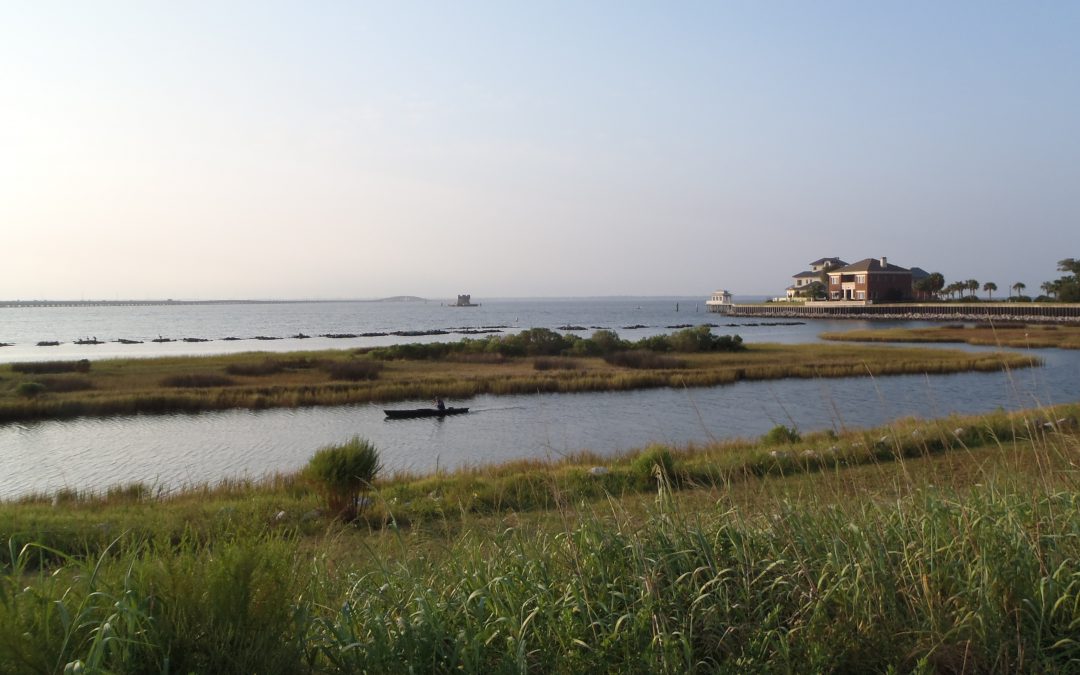
by Rick O'Connor | Oct 6, 2017
Imagine this…
You are a sailor on a 16th century Spanish galleon anchored in a Florida Bay south of Tampa. You, along with others, are ordered to go ashore for a scouting trip to set up a base camp. You transfer over to a small skiff and row ashore to find a forest of root tangled mangroves. There is no dry beach to land so you disembark at the edge of the trees in knee-deep water. The bottom is sandy and your footing is good but you must literally crawl through the tangled mess of mangrove prop roots to finding dry ground. As you do, you encounter spider webs, numerous biting insects, and the bottom becomes muddy and footing is less stable. I am sure I would have returned to the ship to report to the captain that there is nothing of value here – let’s go back to Spain!
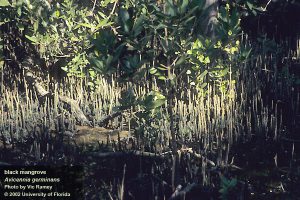
The dense vegetation of a black mangrove swamp in south Florida.
Photo: UF IFAS
Along the shores of northwest Florida it would have been different only that they would have encountered acres of grass instead of trees. The approach to Pensacola would have found a long beach of white sand and dunes. Entering the bay, they would have found salt marshes growing in the protected areas, with the rare exception of dryer bluffs in some spots – which is where de Luna chose to anchor. These marshes are easier to traverse than the emergent root system of the mangrove, but the muck and mire of the muddy bottom and biting insects still remain.
For centuries, Europeans have sought to alter these habitats to make them more suitable for colonization. Whether that was for log forts and houses or marinas and golf courses, we have cleared the vegetation and filled the muck with fill dirt. But have we lost something by doing this?
Yes… Yes we have, and some of what we have lost is valuable to us.
We have lost our water quality.
These emergent shoreline plants filter debris running from shore to the sea during rain events. The muck and mire we encounter within the marsh would otherwise entered the bay or bayou. Here it would cloud the water and smother the submerge seagrasses. My father-in-law told me that as a kid growing up on Bayou Texar in Pensacola he remembered clear water and seagrasses. He remembered throwing a cast net and collecting 4-5″ shrimp.
That has changed.
In our modern world, it is not just mud that is running off towards our bays. We can add lawn fertilizers, lawn and garden pesticides, oils and grease from cleaning, and a multitude of other products – including plastics.
We have seen a decline in living resources.
The large shrimp my father-in-law talked about are not as common. He spoke of snapper – very few now. Bay scallops are basically gone in Pensacola and have declined across much of Florida’s gulf coast. Horseshoe crabs have become rare in many locations. Moreover, salt marsh/mangrove dependent species, such as diamondback terrapins, are difficult to find.
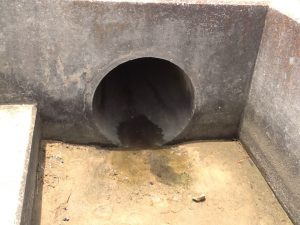
Storm drains, such as this one, discharge run-off into local bays and bayous.
Photo: Rick O’Connor
Maybe of more concern is the decline of commercially important aquatic species such as crabs, shrimp, and finfish. It is known that 80-90% of these commercially important species spend at least part of their lives in the marshes and mangroves.
And this we are losing.
And then there is the shoreline itself.
The emergent plants the Spanish encountered actually act as a wave break. Sand running off the land is trapped to form a “beach”, albeit a mucky one, and the wave energy is absorbed by the plants reducing the energy reaching the shore. The damage in south Florida from hurricane Andrew was devastating. But that same storm made a second landfall in the marshes of Louisiana and there was little to write about – the marsh absorbed much of the energy. The removal of these vegetated shorelines has enhanced the loss of coastline across the Gulf States.
Can we restore these shores and return these “services”?
Yes…
Whether communities want to or not is another question, but we can.
Studies have shown that a marsh 10′ across from water to land can remove 90% of the nutrients running off. Nutrients can trigger hypereutrophic conditions in the bay – which can lead to algal blooms – which can lead to low dissolved oxygen – which can lead to fish kills and seagrass loss. In addition to removing nutrients, marshes and mangroves can remove a variety of other contaminants and plastics. Many sewage treatment facilities discharge their treated effluent through the coastal plant communities before it reaches the bay, thus improving water quality.
We know that restoring a living shoreline will enhance the biological productivity of the bay. Studies have shown that swamps and marshes can produce an annual mean net primary production of between 8000 – 9000 kcal/m2/year, which is equivalent to tropical rainforest and the open estuary itself.
Finally, living shorelines will stabilize erosion issues, much longer than seawalls and other harden structures. Studies have shown that seawalls will eventually give in. Wave energy is increased when it meets the wall and reflects back. This generates higher energy waves that decrease seagrasses and actually begins to remove sediment around the wall itself. You will see the land begin to erode behind the wall and eventually it begins to fall forward into the bay. The east coast of Florida recently experienced this during hurricane Irma. Interestingly the west coast experienced negative tides. The exposure of these seawalls to an empty bay had the same effect. Without the water pressure to hold them, they began to crack and fall forward. A living shoreline can sustain all of this.
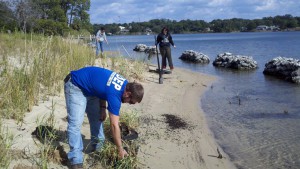
FDEP planting a living shoreline on Bayou Texar in Pensacola.
Photo: FDEP
So how do restore my shoreline?
- You will need a permit. The state of Florida owns land from the mean high tide seaward. To plant above this line you do not need a permit, but you will want to plant at and below to truly restore and benefit from the services. Permitting can be simple or complicated – each property is different. Visit http://escambia.ifas.ufl.edu/permitting-living-shorelines/ to learn more about the process.
- You will need plants. There are a few nurseries that provide the needed species. There is a zonation to the plant community and it is important to put the right plant in the right place. The above link can help with this and the Extension office is happy to visit your location and give recommendations.
- You will need to plant them. Fall and spring are good planting times. A recent project we helped with planted in April and it has been very successful.
- You may want to monitor the success of your project. This not needed, but if interested the Extension office we can show how to do this.I certainly understand why many would rather remove these shoreline ecosystems, but I think you can see the benefits outweigh the problems. It is not an all or none deal. Living shorelines can be designed to allow water access. If interested in learning more contact your county Extension office.
I certainly understand why many would rather remove these shoreline ecosystems, but I think you can see the benefits outweigh the problems. It is not an all or none deal. Living shorelines can be designed to allow water access. If interested in learning more contact your county Extension office.
References
Permitting a Living Shoreline; can a living shoreline work for you? http://escambia.ifas.ufl.edu/permitting-living-shorelines/.
Miller Jr., G.T., S.E. Spoolman. 2011. Living in the Environment: Concepts, Connections, and Solutions. 16th edition. Brooks and Cole Cengage Learning. Pp. 674.
Sharma, S. J. Goff, J. Cebrian, C. Ferraro. 2016. A Hybrid Shoreline Stabilization Technique: Impact of Modified Intertidal Reefs on Marsh Expansion and Nekton Habitat in the Northern Gulf of Mexico. Ecological Engineering 90. Pp 352-360.
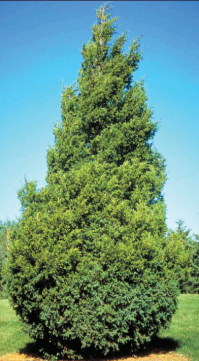
by Carrie Stevenson | Jan 8, 2017
Arbor Day has a 145-year history, started in Nebraska by a nature-loving newspaper editor who recognized the many valuable services trees provide. We humans often form emotional attachments to trees, planting them at the beginning of a marriage, birth of a child, or death of a loved one, and trees have tremendous symbolic value within cultures and religions worldwide. So it only makes sense that trees have their own holiday. The first Arbor Day was such a big success that his idea quickly spread nationwide–particularly with children planting trees on school grounds. In addition to their aesthetic beauty and valuable shade in the hot summers, trees provide countless benefits: wood and paper products, nut and fruit production, wildlife habitat, stormwater uptake, soil stabilization, carbon dioxide intake, and oxygen production. If you’re curious of the actual dollar value of a tree, the handy online calculator at TreeBenefits.com can give you an approximate lifetime value of a tree in your own backyard.
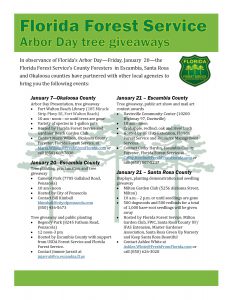
Arbor Day events in the western Panhandle.
While national Arbor Day is held the last Friday in April, Arbor Day in Florida is always the third Friday of January. Due to our geographical location further south than most of the country, our primary planting season is during our relatively mild winters. Trees have the opportunity during cooler months to establish roots without the high demands of the warm growing season in spring and summer.
To commemorate Arbor Day, many local communities will host tree giveaways,plantings, and public ceremonies. In the western Panhandle, the Florida Forest Service, UF/IFAS Extension, and local municipalities have partnered for several events, listed here.
For more information on local Arbor Day events and tree giveaways in your area, contact your local Extension Office or County Forester!
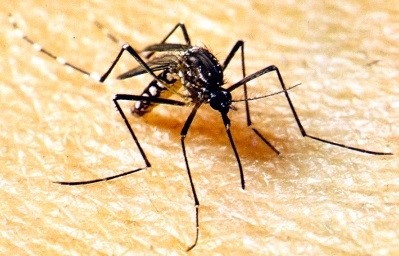
by Sheila Dunning | Mar 12, 2016
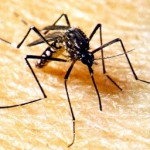 With all the news about the Zika virus spread in Florida, now is the time to start thinking about mosquito protection. As the weather warms, they will be hatching. Check out where the water is collecting in your yard. The female Aedes aegypti mosquitoes lay their eggs in temporary flood water pools; even very small ones such as pet watering bowls, bird baths and upturned Magnolia or Oak leaves. Dumping out the collection containers and raking through the leaves every couple of days can greatly reduce the population.
With all the news about the Zika virus spread in Florida, now is the time to start thinking about mosquito protection. As the weather warms, they will be hatching. Check out where the water is collecting in your yard. The female Aedes aegypti mosquitoes lay their eggs in temporary flood water pools; even very small ones such as pet watering bowls, bird baths and upturned Magnolia or Oak leaves. Dumping out the collection containers and raking through the leaves every couple of days can greatly reduce the population.
Becoming infected with Zika virus is not common. Though the disease can be transmitted by mosquitoes, blood transfusions or sex, the only know infections in Florida were from people who had been “bitten” by mosquitoes while travelling to countries with active virus outbreaks. That is until this past week, when a person-person infection occurred between a man that had been infected while out of the country and the woman he returned to in Florida. Mosquitoes usually obtain the virus by feeding on infected people, who may not exhibit any symptoms because they have been exposed and their body has built an immunity to the virus. Once the mosquito has drawn infected blood from the person, the infected mosquito “bites” another human, transmitting the virus mixed in saliva into the blood stream of the second host. If the second host is a susceptible pregnant woman, there is a risk of birth defects for the unborn child. If the infected host is a man, he can transmit the virus in semen for about two weeks.
Government public health officials here in Florida are able to monitor mosquito-borne illnesses quickly and effectively. Though the daily news can be alarming, the awareness is truly the message.
To protect yourself and reduce the sources for mosquitoes to breed, here are a few pointers:
Stay indoors at dusk (peak mosquito biting time).
If you must be outside, wear long sleeves and pants and/or mosquito repellents containing the active ingredient DEET.
Repair torn door and window screens.
Remove unnecessary outside water sources.
Flush out water collected in outdoor containers every 3-4 days.
Disturb or remove leaf litter, including roof gutters and covers on outdoor equipment.
Apply larvicides, such as Bacillus thuriengensis israelensis (BTI) to temporary water holding areas and containers.
The mosquitoes have been around all winter with the milder weather and frequent rain. As spring approaches they will be laying eggs on all the water surfaces they can find. As you venture out into the yard or travel to the great outdoors, remember to protect yourself and look at all the ways you can remove the potential habitats for the pesky creatures.
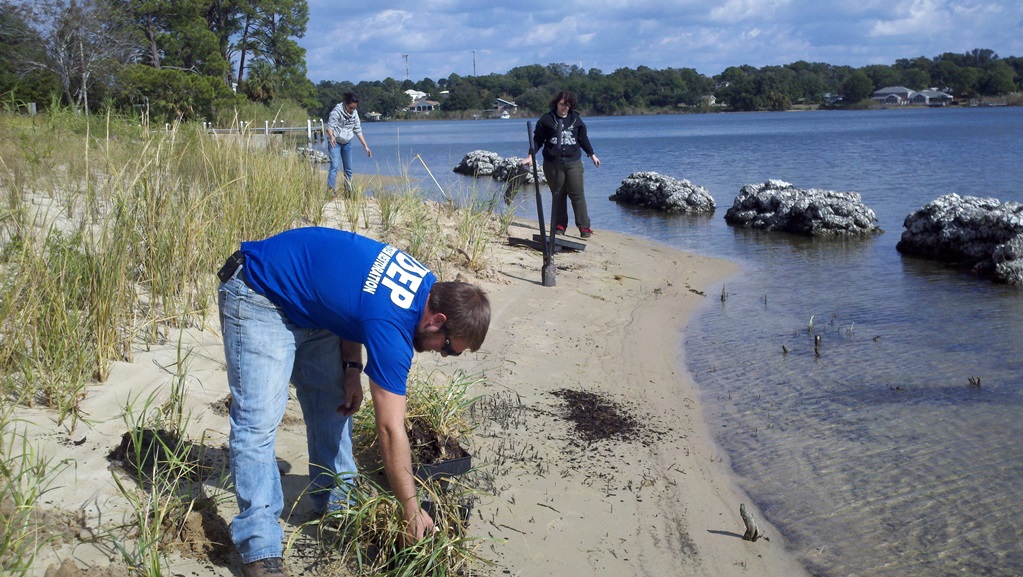
by Rick O'Connor | Sep 25, 2015
In the last edition in this series we discussed some of the issues and problems our estuaries are facing. For the final edition for National Estuaries Week we want to leave you with some ideas on you can help improve things.
The first issue we dealt with was eutrophication – or nutrient overloading. The primary nutrient we have issues with in this part of the panhandle is nitrogen. Nitrates can converted from other forms of nitrogen and can be discharged directly into the water. Common sources are leaf litter, animal waste, commercial fertilizers, and human sewage. Most of this is discharged into our waters via stormwater runoff. This runoff occurs from our properties (due to the lack of natural vegetation holding it) and from stormwater drains (where it is directed through our engineering projects).
One method of dealing with this problem is restoring the shoreline back to its natural state. This is called Living Shorelines and they are being restored all over the country. In most cases locally Living Shorelines would be restoring salt marshes to our shorelines. There are some issues with this. It lessens the amount of open beach you have to enjoy. You have to purchase special plants to do this, and it may require a permit from the state of Florida. Permits are required only if you are planting at or below the mean high tide line; all submerged lands are actually the property of the state of Florida. Permits for Living Shorelines can be obtained from the Florida Department of Environmental Protection.

FDEP planting a living shoreline on Bayou Texar in Pensacola.
Photo: FDEP
The first question you would want to ask when considering a Living Shoreline for your property is whether there was a salt marsh along your shore historically. Salt marshes require low energy beaches to establish themselves and your location may not be such. If you are not sure you can contact the Sea Grant Agent in your county to provide assistance with that determination. If you feel your property would support a Living Shoreline then you will need a permit. There is the “long form” and the “short form” permit. The “short form” obviously what you want and it costs less also. However certain criteria must be met in order to be exempt from the “long form”. To determine whether you are exempt from the “long form” visit https://www.flrules.org/gateway/RuleNo.asp?title=ENVIRONMENTAL%20RESOURCE%20PERMITTING&ID=62-330.051 Click “view rule” and scroll down to (12)(e). If you feel that you qualify for the exemption then it is as simple as completing the form and submitting your check. You should have your permit in just a few weeks. If you do not qualify then it is recommended that you contact the Florida Department of Environmental Protection for advice on moving forward. (850) 595-8300.
Whether you qualify for a Living Shoreline or not – or even if you do not live on the water – there is a landscaping program that you can adopt that will help a lot. It is called Florida Friendly Landscaping. This UF/IFAS program helps homeowners select the “right plant for the right place”. Basically the idea is to landscape your yard with native plants that require little or no fertilizing or water. Not only does this program help our estuaries it saves the homeowner money. One of the first things you will want to do when planning a Florida Friendly Landscape is have your soil tested. The county extension office provides this service for about $7. If interested contact your county extension office about where to pick up the soil testing sample bags. Rain barrels and rain gardens are also good ways to reduce water runoff and save water for those times when you might need it. A trickle hose connected to a rain barrel can reduce runoff and your water bill.
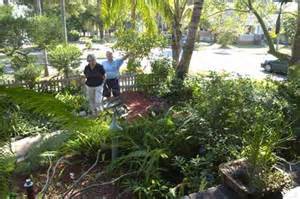
Florida Friendly Landscaping involves using native plants that require less water and fertilizer.
Photo: Southwest Florida Water Management District
We are not certain how much of the animal waste is in fact human but we do know that much of the human waste is from septic tanks. If you have a septic tank – maintain it. Most of the problems come from those that are not maintained well. If you can connect to a sewer line we recommend you do this. The sewer is not without its problems but the problems are much reduced. If you own a pet – clean up behind them.
The leaf litter problem is just that… a problem. Within the city limits many municipalities will collect your yard waste. In Pensacola they do so using a large “claw” however this claw leaves large holes in your yard – so people place the yard waste in the street. Doing this encourages runoff into the bay and the problems we have already discussed. So many will bag it. In Escambia County the yard waste is converted into mulch and is free to the public. However if the yard waste is placed in plastic bags they cannot do this. It’s tough problem. One answer is to develop your own compost pile and dispose of your yard waste there. Your county extension office can help you with different methods of composting and help you select the method that is best for you.
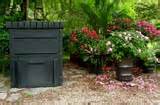
A commercial composting bend that can purchased at many locations or on line.
Photo: UF/IFAS
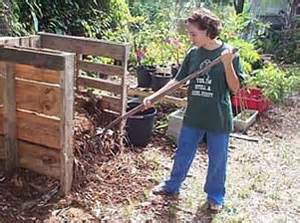
Composting bends can also be made from recycle materials such as pallets.
Photo: UF/IFAS
All of these suggestions about can reduce nutrients and bacteria in our waterways that contribute to fish kills and health advisories. It will reduce turbidity, which will help seagrasses, and actually Living Shorelines can reduce shoreline erosion.
These same practices can not only improve water quality they could help restore some of our declining fisheries. Living Shorelines provide needed habitat for many commercial and recreational valuable species. As mentioned, these projects will remove much of the sediment improving water clarity to a point where seagrasses can restore themselves and who knows… maybe the scallop will return. On the subject of scallops, Florida Sea Grant conducts scallops surveys in some of panhandle estuaries in the summer. You can volunteer to be a scallop surveyor and assist with data collection that could support a scallop restoration projects. When fishing follow the regulations. They may seem unfair and out dated but know that fisheries managers are trying to get it right and your cooperation will certainly help develop a sustainable fishery for years to come.
The issue of garbage is another tough one. We have been conducting educational programs for decades trying to reduce the amount of solid waste – it’s still there. Many of the local residents are pretty good at taking their trash with them and recycling monofilament fishing line… but not all. Encourage your friends to “take it with them” and “leave no trace” when they go home each day. Out of town visitors can be a problem. Local education from all of us should help some. Participate in one of the CleanPeace’s Ocean Hours. If in the Santa Rosa and Escambia area contact the Sea Grant Agents from those counties for more information. If from another county, contact your local county extension office for information on beach clean ups.
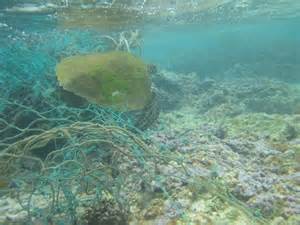
A sea turtle entangled in a discarded fishing net.
Photo: NOAA
Our estuaries have improved significantly from where they were in the late ‘60’s and early 70’s. A little on our part now we can improve them even more. We hope you have learned something new about your local estuary during National Estuaries Week. We hope you will take the time to enjoy these great bodies of water and do what you can to protect for future years.
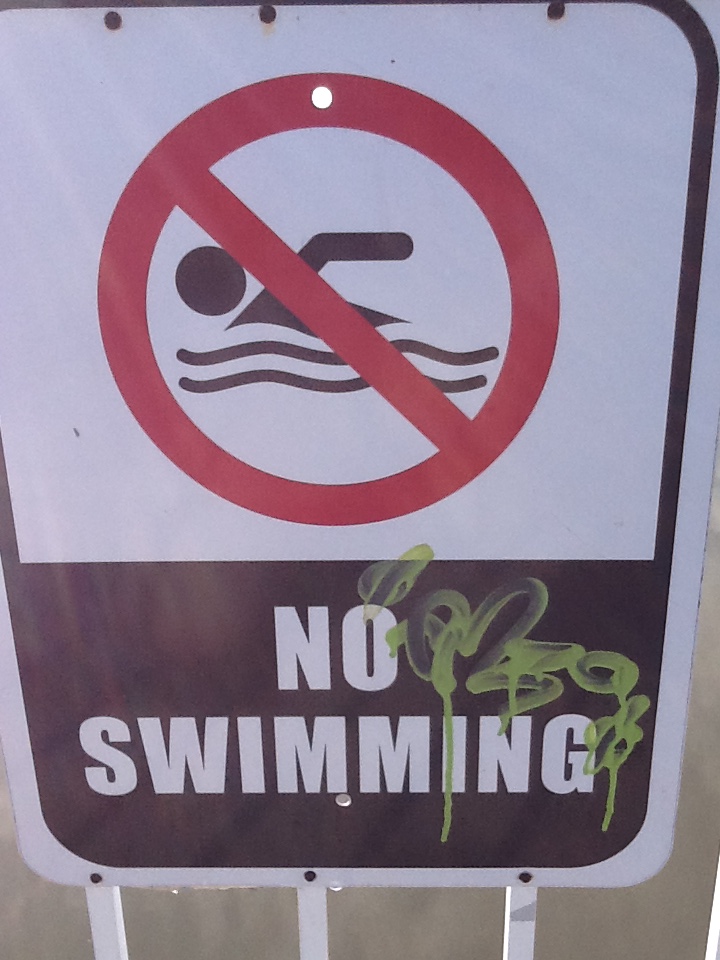
by Rick O'Connor | Sep 24, 2015
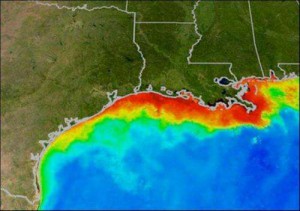
The red area indicates where dissolved oxygen levels are low.
I don’t want this to sound like a “Debbie Downer”… but there are problems with our estuaries and panhandle residents should be aware of them. There are things you can do to correct them – which we will discuss in the final issues of this series – but you need to understand the problem to be able to solve it. Unfortunately there are many issues and problems our bays and bayous face and we do not have time in this short article to discuss them all, but we will discuss some.
We’ll start at the top… with our rivers. Since the founding of our nation many communities were built on estuaries; those that were not were built on the rivers. Water was an easy way to move throughout the country – much easier than wagon crossing over the Appalachians or through a bog. There are several communities that developed along the rivers that feed the panhandle bays. Though the situation has improved in the last few decades, most of these communities have used these rivers as a place to dump their waste. Assorted chemicals, sewage, and solid waste were discharged… and it all came down to us. The Mississippi River is an example of this problem. Discovered in the 1990’s the Louisiana Dead Zone is an area in the Gulf where the levels of dissolved oxygen are so low that little or no life can be found on the ocean floor there. It is believed to be trigger by nutrients, chemical fertilizers and animal waste, being discharged upstream. These nutrients create a bloom of plankton, which can darken the water. Though the phytoplankton can produce oxygen during the daylight hours, they consume it in the evening, lowering the concentration of dissolved oxygen within the water column. The plankton are relatively short lived and eventually die. As the dead plankton fall out to the seafloor bacteria begin to decompose their bodies thus dropping the dissolved oxygen levels further. When the dissolved oxygen concentrations drop below 4.0 millgrams/liter we say the water is hypoxic (low in oxygen). Many species of aquatic organisms begin to stress. At 2.0 mg/L many species will die and we have a “dead zone”. If it reaches 0.0 mg/L we say the water is anoxic (without oxygen). This process is called eutrophication and not only a problem at the mouth of the Mississippi River, it occurs in almost all of the bays and bayous of the panhandle and is the primary cause of local fish kills.
A more recent issue with our rivers has been the reduction of water. In the so called “Water Wars” the state of Georgia has used its damn system to block the flow of the Chattahoochee River to create electricity and a reservoir of drinking water for river communities. Under normal conditions this has not created a problem however in recent years the southeast has experienced drought and the state of Georgia has had the need to hold back water for large communities – such as Atlanta. This has reduced the amount of water flowing towards the Gulf and has impacted communities all along the way. It is not the only issue but is the primary factor triggering the collapse of the oyster industry in Apalachicola. The reduced freshwater flow has increased salinities in the bay. This has disrupted the life cycle of the eastern oyster and has increased both predation and disease within these populations. Apalachicola produces over 90% of Florida’s oysters and 10% of the oysters for the entire country! Oysters are a huge industry in this town. Many are oystermen and many others process the product when it is landed… the industry is on the verge of collapsing. (Learn more).
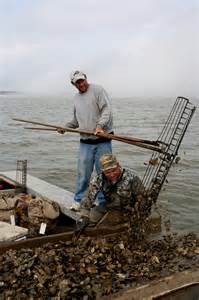
Oysterman on Apalachicola Bay.
Photo: Sea Grant
These are just some the issues stemming from the rivers… what about the issues initiated from the communities that live along the bay…
How about the seafood? We discussed the oyster industry in Apalachicola Bay but oyster production in other local bays has declined as well (for other reasons). Scallops are gone from many of their historic estuaries, shrimp and blue crab landings are down, this year mullet seem to be hard to find. What is going on here? For the most part the decline in seafood products can be tied to either a decline in water quality or from over harvesting. The harvesting issue is easy… do not harvest as much. However these fisheries management decisions impact many lives and has caused a lot of debate. First you need to determine whether the decline is due to overharvesting or some other environmental factor… easier said than done. Certainly the biology of your target species will give you an idea of how many animals you can remove from the system and sustain a healthy population (maximum sustainable yield) but this method has triggered debate as well. Most fishermen do not want to see the fishery collapse and are willing to work with fishery managers to assure this – but they do have bills to pay. Fishery managers have a responsibility to assure the fishery remain for current and future generations of fishermen and they are basing their decisions on the best available science. It is a touchy subject for many and a problem within our estuaries.
The other cause of declining seafood is poor water quality. You can talk to any “ole timer” and they will tell you about the days when the water was clearer, the grass was thicker, and the fish were more abundant… what happen? I spoke with my father-in-law before he passed away about the changes he saw in Bayou Texar in Pensacola. He remembers being able to see the bottom, more seagrass, and being able to catch a variety of finfish as well as shrimp the size of your hand. The first change he remembered was a change in water clarity… it became murkier… and this happen about the time they began to develop the east side of the bayou. As our communities grew more land was cleared for development. The cleared land allowed more runoff to reach the creeks, bayous, and bays. Infrastructure had to be placed to reduce flooding of yards and streets – Bayou Texar has 38 storm drains. All of this led to more runoff into our water ways. With the increase in turbidity the amount of sunlight reaching the bottom was reduced and seagrasses began to decline. Many species of seagrass require salinities of 25 parts per thousand or higher and the increase in freshwater runoff lowered the salinity which also stressed these grasses. Much of this runoff included sand and silt and the grasses were basically buried. All in all seagrasses declined… and with them many of the marine creatures. Salt marshes were removed for coastal developments, industries were located on our rivers and bays and introduced their chemical discharge, and boating activity increased… our estuaries were being literally “loved to death”. I have seen in my lifetime the decline of sea urchins and scallops from our bay, the increase in turbidity, and the decline of seagrasses. But we cannot blame all of this on habitat loss and pollution. Speaking recently with fisheries managers they believe the recent decline in blue crab landings is due to drought. Reduction in rainfall means reduction in river discharge, which means an increase in salinity and a disruption of the crab reproductive cycle.
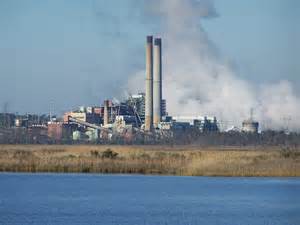
Power plant on one of the panhandle estuaries.
Photo: Flickr
Another problem that is associated with runoff has been the increase in bacteria. Fecal coliform bacteria are found in the stomachs of birds and mammals. They assist with our digestion and are released into the environment whenever we (or they) go to the bathroom. So finding fecal coliforms in the water is not unusual… the problem is TOO many fecal coliforms. As mentioned coliforms are not a threat to us but they are used as an indicator of how much waste is in the water. Feces harbors many other microbes in addition to coliforms – hepatitis and cholera outbreaks have been linked to sewage in the water. So agencies monitor for these each week. Most agencies will monitor for E. coli when sampling freshwater and Enterococcus in saline waters. E. coli values of 800 colonies / 100 milliters of sample or higher, and Enterococcus values of 104 colonies / 100 ml of sample will trigger a health advisory being issued – and some bodies of water being closed. In the Pensacola area the Florida Department of Environmental Protection and the Escambia County Health Department both monitor for bacteria. They post their results each week and I, in turn, post to the community. Our local bayous are averaging between 8-10 advisories each year. The problem with these advisories is that residents who live on the waterways, businesses (such as hotels and ecotours) who use the waterways become concerned about entering the water. It is not good for business or property values if the body of water you are on has high levels of bacteria and signs posting “no swimming”.
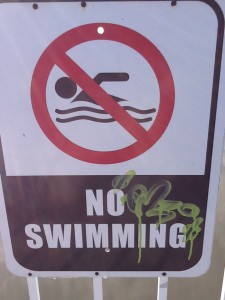
Closed due to bacteria.
Photo: Rick O’Connor
There are many problems our estuaries are facing but for this article we will end with solid waste. Trash and garbage has been a problem since I can remember. Campaigns have been launched each decade to try and reduce the problem but the problem still exist. Plastics and monofilament litter the beaches and waterways creating problems for marine life and an “eye soar” for those enjoying the bay. I am currently working with the Wildlife Sanctuary of Northwest Florida and CleanPeace to monitor solid waste in Pensacola Bay. Each week CleanPeace host a Saturday event they call “Ocean Hour” where they select a location on the bay and clean for an hour. They submit the top three items to me each week and have been doing this since January… it has been pretty consistent… cigarette butts, plastic food wrappers, and plastic drink containers. We are not going to get rid of garbage on our beaches but if we can consistently reduce the “top three” we should be able to reduce the problem.
More on what we can do to help in the final issue.
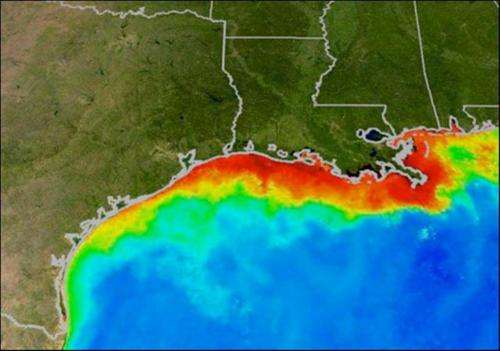
by Rick O'Connor | Jul 10, 2015
What is the Gulf of Mexico Dead Zone you ask? Well…it’s a layer of hypoxic water (low in dissolved oxygen) on the bottom of the Gulf of Mexico. It was first detected in the 1970’s but reached its peak in size in the 1990’s. The low levels of dissolved oxygen decrease the amount of marine life on the bottom of the Gulf within this zone, including many commercially valuable species supporting the Gulf seafood industry.

The red area indicates where dissolved oxygen levels are low.
What Causes this Dead Zone?
Drops in concentrations of dissolved oxygen within the water column can occur for a variety of reasons but is usually caused by one of two reasons. (1) Increasing water temperatures—as water temperature increases, its ability to hold dissolved oxygen decreases. (2) A process called eutrophication.
What is eutrophication?
Eutrophication is a process where an increase of nutrients in an aquatic system triggers an algal bloom of microscopic phytoplankton. These phytoplankton produce oxygen during the daylight hours but consume it in the evening. Once the bloom dies, decomposing bacteria begin to break them down and consume larger amounts of dissolved oxygen in doing so. When the dissolved oxygen concentrations drop below 2.0 mg/L we say the water is hypoxic and many marine organisms either begin to move out or die. The nutrients that trigger such blooms are primarily nitrates and phosphates. These can be introduced to the water column with plant and animal waste and with synthetically produced fertilizers we use on our fields and lawns. There is natural eutrophication, but when the process is triggered or accelerated by human activity we use the term cultural eutrophication.
So which is it; warming waters or eutrophication?
The Gulf of Mexico Dead Zone usually forms in spring and lasts through September. These are certainly the warmer months of the year, but the warmer waters are near the surface and much of the water column is not warm enough to cause this. Another point is that the Dead Zone is near Louisiana and there are warm locations in other parts of the Gulf where dead zones do not occur. However the Mississippi River does discharge near Louisiana. This river drains 41% of the continental United States, which contains 52% of the nation’s farms. The agricultural waste (plant, animal, and synthetic fertilizers) discharged into the Mississippi River contains nitrogen and phosphorus, the two key nutrients that trigger algal blooms. Based on this, most scientists agree that cultural eutrophication is the primary cause of the Gulf Dead Zone.
When they say it will be a “typical year”, what does that mean – what is a “typical year”?
Scientists from NOAA, the U.S. Geological Survey, and six partnering universities have released their annual forecast of the Dead Zone. The 2015 prediction has the area of the dead zone about equal to the size of Connecticut, which has been the average size for the past several years. This is what they mean by typical.
Can these dead zones occur in our area waters?
Yes, and they do. We do not typically call them “dead zones” but the same process occurs all over the world, including the bays of the Florida panhandle.
What can we do to reduce cultural eutrophication locally?
If you can do without fertilizing your lawn (or field), then do. If this is not an option then only put the amount of fertilizer required for your land/lawn. Most people over fertilize, which not only reduces water quality but is expensive for the property owners. If you can compost your plant waste, do so. With animal waste, please dispose of properly, in a manner where it not reach local waterways.
For more information on hypoxia, eutrophication, and solutions to reduce this problem, contact your county Extension office.
http://www.tulane.edu/~bfleury/envirobio/enviroweb/DeadZone.htm
http://www.iseca.eu/en/science-for-all/what-is-eutrophication
http://earthobservatory.nasa.gov/Features/Phytoplankton/



















